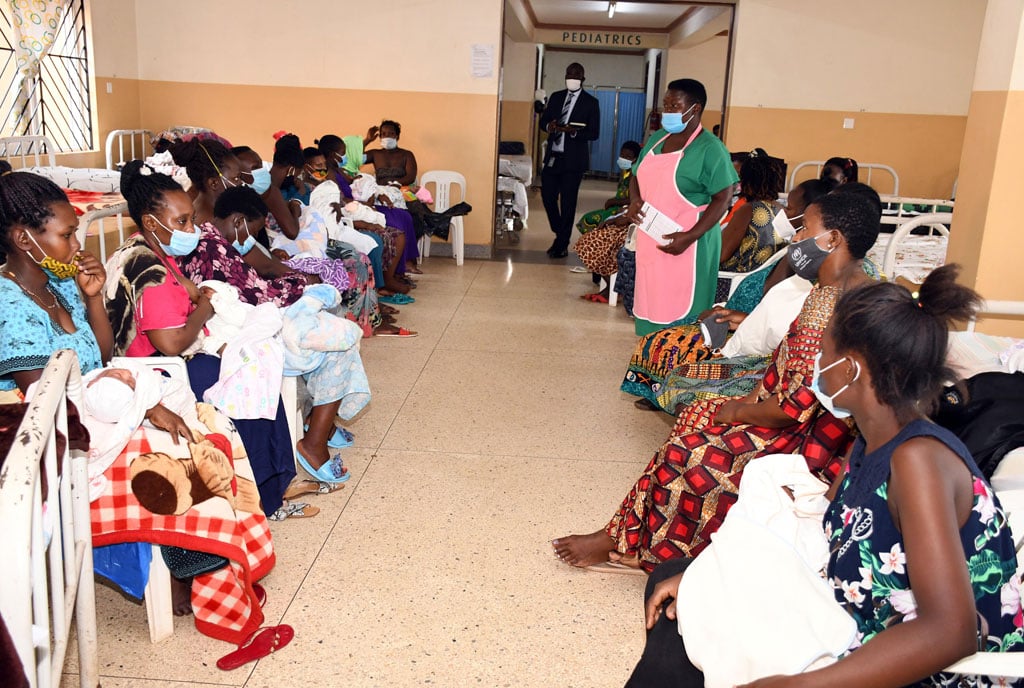
Mothers are taken through postnatal counselling at Kisenyi Health Centre IV in Kampala in April 2021. People in some regions with poor coverage of health facilities and poor water and sanitation indicators also had better life expectancy. PHOTO/FILE
In a tale of two lifestyles and mixed fortunes, some richer Ugandans are dying earlier while their poorer counterparts are living longer.
Our analysis of two separate reports from Uganda Bureau of Statistics (Ubos) and another from the World Bank show that people in regions with high poverty rates live longer than those in areas with lower poverty rates and better access to social services.
We compared twin data from Ubos 2022 Multidimensional Poverty Index report and the 2024 National Population and Housing Census report released in Kampala on Thursday last week, and the 2023 World Bank poverty report.
The multidimensional poverty index measures the deprivation people face in accessing education, healthcare and employment.
In eastern and northern regions, which have poverty rates of 40 percent and above, people on average live 70 years and above. But in central and western regions, which have lower poverty rates of between 15 and 26 percent, the life expectancy is 63 and 64.7, respectively, according to the census and World Bank reports.
The 2024 census report, which specifically measured life expectancy at birth, indicates that in general, the average life expectancy has improved in the country from 63 in 2014 to 68 in 2024. The government provided a generalised explanation for the increase in life expectancy and didn’t explain the variation.

An elderly woman answers questions from a census enumerator from the streets of Kampala on Census night. Photo | Abubaker Lubowa
Life expectancy at birth is the average number of years that a newborn is expected to live if the current mortality rates continue to apply, according to Ubos and health research experts.
“Between 2014 and 2024, males gained more four years and females six in their life expectancy at birth. This could be attributed to improvement in childhood mortality rates as they are core in determining the life expectancies at birth,” the Ubos report read in part.
Ubos further explained that life expectancy at birth is a measure that is often used to gauge the overall health and well-being of a nation.
The agency said the measure gives a summary of the mortality experience of the population at all ages and that “an increase in life expectancy could be attributed to improvements in healthcare”.
However, people in some regions with poor coverage of health facilities and poor water and sanitation indicators also had better life expectancy.
Dr Ronald Olum, a research associate at Makerere University School of Public Health, said the genetic makeup, environment and lifestyle could explain the variations across the regions.
“There are many types of life expectancy that we work with –there is life expectancy at birth but there is also healthy life expectancy which looks at both the quantity and duration of the period you lived but also the quality of life that you lived –things around illnesses,” Dr Olum observed.
The research associate, who is based at the Department of Community Health and Behavioural Sciences, noted that for the life expectancy at birth, the improvement could be attributed to better healthcare.
“From the Ubos report, they linked the improvement to a decrease in neonatal and under-five mortality. Vaccination of children has also improved. But this may not explain the entire picture,” Dr Olum argued.
“West Nile has one of those high infant and under-five mortality rates in the country but also the rates tend to be higher in the Ankole [Sub-]region, which may explain lower life expectancy. The best explanation could thus be the social determinants of health,” he added.
Dr Olum further explained that available theories indicate that how long you live could be determined by a lot of non-medical things. He said urbanisation and associated vices have played a significant role in the variations.
“This can include your genetics, individual lifestyle, how you eat, whether you take substances like alcohol and also your living condition, education and agriculture; all determine how long we live,” he said.
“My thinking points towards urbanisation. We see that the central region, which has a shorter life expectancy, is highly urbanised. If you go to a common slum or many of these urban settings, you will find many people taking these unhealthy diets –ultra-processed foods, compared to other regions,” he noted.
“When you look at the households that do agriculture, the most [and can eat local/unprocessed food harvested from the garden], they are from the Northern region. Issues around data can also be questioned,” he added.
A study by Dr Joshua Baalwa of Makerere University Medical School and colleagues found the overall prevalence of obesity and overweight in Kamuli (eastern region) was 2.3 percent and Kampala (central region) at 10.4 percent.
“The prevalence of obesity was 4.4 percent in Kampala and 0 percent in Kamuli while the prevalence of overweight was 10.2 percent in Kampala and 10.6 percent in Kamuli,” the report read.

Achieving optimal weight requires maintaining a healthy diet and regular physical activity. PHOTO/COURTESY
The researchers noted that obesity in young adults is rising and predicts diabetes and cardiovascular diseases later in life, which make up part of the non-communicable diseases contributing to about 40 percent of deaths in Uganda.
Dr Olum on the other hand said there are higher levels of air pollution, which is a major cause of diseases of the lungs and heart, increasing death risks and thus shorter lifespan.
Are we truly rich?
In developed countries such as the United States of America, the rich are living a healthier and longer life because of a higher chance of getting healthier diets and accessing better healthcare.
“Poor adults are almost five times as likely to report being in fair or poor health as adults with family incomes at or above 400 percent of the Federal Poverty Level (FPL). In 2014, the FPL was $23,850 (Shs86.8m per year) for a family of four,” wrote the Urban Institute, a Washington, D.C.–based think tank that conducts economic and social policy research.
“… and they (poor adults) are more than three times as likely to have activity limitations due to chronic illness. Low-income American adults also have higher rates of heart disease, diabetes, stroke, and other chronic disorders than wealthier Americans,” the institute added.
Urbanisation may not be synonymous with prosperity/riches as many poor people move from rural areas to live in slums in Kampala and other budding cities across the country. Until recently, many in Uganda still viewed having huge bellies (fatness), a major risk factor for non-communicable diseases, as a sign of wealth but this is changing as healthy eating campaigns create impact.
The annual Gross Domestic Product (GDP) Per Capita by the end of 2023 was 1,093 in Uganda, which is lower than the USA’s $65,020 (Shs237m) by the end of 2023, indicating that the concept of riches might also vary.
Good genes save
Dr Misaki Wayengera, a geneticist in the Department of Immunology and Molecular Biology at Makerere University, said inherited genes from parents have been dictating how long human beings live.
“Besides environmental effects, how long someone lives has a lot to do with their genetic makeup. There are families where people live longer and this reveals there is much we inherit from our parents that dictates whether we live long or die early,” the expert explained.

An old lady. PHOTO/FILE
These inherited genes, Dr Misaki said, can delay the ageing process by conferring stronger immunity and protecting individuals from life-threatening diseases like malaria, hypertension, and diabetes.
“Aging starts at gene level then outwardly expresses as the grey hair on the head, heart diseases and ageing-related complications,” he noted, adding that there is a disease called Progeria that makes people age earlier than normal.
Low HIV burden
HIV/Aids is one of the major causes of premature death in Uganda. The Uganda Aids Commission fact sheet for 2024 indicates that districts in some of the regions with high life expectancy also had HIV prevalence lower than the national average. Up to 20,000 Aids-related deaths were registered in Uganda in 2023.
Areas with low urbanisation such as Nabilatuk in Karamoja and Maracha in West Nile had HIV prevalence of 0.5 percent and 1.1 percent, which is several times below the national average prevalence of 5 percent. Even in more urbanised areas of West Nile –Arua District and Arua City, HIV prevalence is at 2.8 percent and 3.8 percent, respectively.
However, in Masaka and Masaka City, the prevalence was at 9.2 and 11 percent respectively, all above the national average. According to information from the Swedish International Development Cooperation Agency (Sida), HIV burden has been high in urban areas in Uganda and other African countries because of a combination of higher levels of mobility and sexual networking than in rural communities.
“Poverty, combined with urban anonymity, increases risk behaviours such as transactional and age-disparate sex,” Sida noted in their Urban Issue Paper, reinforcing the local leaders and medical experts.
Dr Stephen Asiimwe, a medical doctor and a researcher at the UAC, said the leading risk factors for HIV infections include having “multiple concurrent partners, transactional sex, lack of use of condoms, cross-generational sex, early sex, and alcohol use” among others.
However, with good adherence to anti-retroviral drugs, Dr Dan Byamukama, the head of HIV prevention at UAC, said the AIDS-related deaths will be reduced and the risk of HIV transmission during intercourse will also drop as many become virally suppressed.
Declining death rates
The sub-regions, which had high under-five mortality, also had lower average life expectancy. Karamoja and Teso had under-five mortality of 18 and 31 per 1000 live births, respectively. While Ankole and Tooro had under-five deaths of as high as 62 and 60 per 1000 live births, respectively.
Mr Amos Lugoloobi, the state minister for Planning at the Finance ministry, however, noted that child and maternal motility rates have declined in the country due to improved access to health services.
The minister said maternal mortality had declined to 207 per 100,000 live births compared to 380 per 100,000 live births registered in the previous census in 2014,” which is a very big improvement.”
“The under-five mortality rate has decreased to 46 per 1,000 live births compared to 74 per 1,000 live births reported in the 2014 census. We have improved the national life expectancy, now, starting at 68 years, compared to 63 years in 2014 which was also an improvement from 50 years in 2002,” he notes.
Dr Olum said lower under-five mortality rates reported in Eastern and Northern regions than central and western regions could be attributed to under-reporting of deaths.
“The eastern and northern regions have fewer healthcare facilities than central and I think western regions, to my surprise, Karamoja has the lowest infant mortality rate,” he said.
“I think the deaths are under-reported. Many of these children die as a result of malaria, neonatal diseases and HIV/Aids. But the vaccination rate has also increased,” he added.
Women live longer than men
The Ubos data also indicates that although life expectancy increased to 68, men are on average dying earlier than women –at the age of 67 for men against 70 for women.
A public health physician, Dr Patrick Tusiime, said besides genetics, the inability of men to withstand stress, risky behaviour and poor health-seeking habits can explain the shorter life of men.
“Men can’t withstand stress as easily as women do. Priding with heavy muscles in the physical world, yet inside them, men yearn to be treated like babies,” Dr Tusiime explained.
He said there are more early and premature deaths of men resulting from the struggle to get or retain sex mates.
“Men will fight, stab and kill their fellow men over women,” Dr Tusiime said, adding that this is contributing to the low life expectancy of men in the country.
“There are more men drowning in alcoholism and other drug addictions than women. It is also easier to catch a man in bad driving, theft and other crimes than it is to find women,” Dr Tusiime said.

A drug user injects himself with heroin, one of the expensive drugs on market. PHOTO/FAISWAL KASIRYE
Dr Tumusiime explained that these health-endangering habits predispose men to diseases and reactions from the public that eventually make them die early.
Dr Tusiime also cited the work choices men make such as joining the military and becoming boda boda cyclists among other extra-laborious work engagements as the other factors contributing to a shorter lifespan in men.
“You can manage to live a good life but imagine you are a military person in war, you may sometimes not escape the bullets, and this will kill you prematurely,” Dr Tusiime noted.




